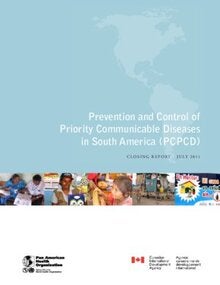Prevention and Control of Priority Communicable Diseases in South America (PCPCD): Closing Report

|
I n 2002, the Canadian International Development Agency (CIDA) approved funding for a Program to be executed by the Pan American Health Organization (PAHO) on the prevention and control of communicable diseases in South America, which aimed at closing health gaps in specific priority population groups in the Region. The Program, the Prevention and Control of Priority Communicable Diseases in South America (PCPCD), was initially approved for CAD$ 10,000,000 for a six year period, beginning in September 2002. The goal of the PCPCD is to contribute to the reduction of morbidity, mortality and disability from those communicable diseases that are responsible for the greatest burden of morbidity and mortality among populations in Colombia, Ecuador, Paraguay, Peru, and Venezuela. These diseases included: sexually transmitted infections (STIs), tuberculosis, Chagas disease, dengue, and prevalent childhood illnesses. The Program also included a cross-cutting component on gender equality and one on human resources development. The objective of the PCPCD is to strengthen the capacity of national institutions responsible for planning, managing and providing sustainable, integrated and gender sensitive programs to prevent and control the most prevalent communicable diseases that cause the greatest number of deaths and disability. It would do so by complementing the current activities for the prevention and control of communicable diseases in the participating countries with the aim to close the gaps of the national programs, emphasizing the most vulnerable and marginalized populations, such as indigenous populations and prisoners. |
